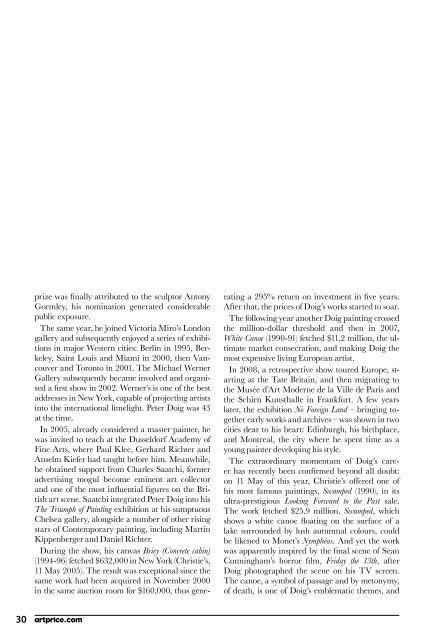THE contemporary
mMjqAT
mMjqAT
Create successful ePaper yourself
Turn your PDF publications into a flip-book with our unique Google optimized e-Paper software.
prize was finally attributed to the sculptor Antony<br />
Gormley, his nomination generated considerable<br />
public exposure.<br />
The same year, he joined Victoria Miro’s London<br />
gallery and subsequently enjoyed a series of exhibitions<br />
in major Western cities: Berlin in 1995, Berkeley,<br />
Saint Louis and Miami in 2000, then Vancouver<br />
and Toronto in 2001. The Michael Werner<br />
Gallery subsequently became involved and organised<br />
a first show in 2002. Werner’s is one of the best<br />
addresses in New York, capable of projecting artists<br />
into the international limelight. Peter Doig was 43<br />
at the time.<br />
In 2005, already considered a master painter, he<br />
was invited to teach at the Dusseldorf Academy of<br />
Fine Arts, where Paul Klee, Gerhard Richter and<br />
Anselm Kiefer had taught before him. Meanwhile,<br />
he obtained support from Charles Saatchi, former<br />
advertising mogul become eminent art collector<br />
and one of the most influential figures on the British<br />
art scene. Saatchi integrated Peter Doig into his<br />
The Triumph of Painting exhibition at his sumptuous<br />
Chelsea gallery, alongside a number of other rising<br />
stars of Contemporary painting, including Martin<br />
Kippenberger and Daniel Richter.<br />
During the show, his canvas Briey (Concrete cabin)<br />
(1994-96) fetched $632,000 in New York (Christie’s,<br />
11 May 2005). The result was exceptional since the<br />
same work had been acquired in November 2000<br />
in the same auction room for $160,000, thus generating<br />
a 295% return on investment in five years.<br />
After that, the prices of Doig’s works started to soar.<br />
The following year another Doig painting crossed<br />
the million-dollar threshold and then in 2007,<br />
White Canoe (1990-91) fetched $11.2 million, the ultimate<br />
market consecration, and making Doig the<br />
most expensive living European artist.<br />
In 2008, a retrospective show toured Europe, starting<br />
at the Tate Britain, and then migrating to<br />
the Musée d’Art Moderne de la Ville de Paris and<br />
the Schirn Kunsthalle in Frankfurt. A few years<br />
later, the exhibition No Foreign Land – bringing together<br />
early works and archives – was shown in two<br />
cities dear to his heart: Edinburgh, his birthplace,<br />
and Montreal, the city where he spent time as a<br />
young painter developing his style.<br />
The extraordinary momentum of Doig’s career<br />
has recently been confirmed beyond all doubt:<br />
on 11 May of this year, Christie’s offered one of<br />
his most famous paintings, Swamped (1990), in its<br />
ultra-prestigious Looking Forward to the Past sale.<br />
The work fetched $25.9 million. Swamped, which<br />
shows a white canoe floating on the surface of a<br />
lake surrounded by lush autumnal colours, could<br />
be likened to Monet’s Nymphéas. And yet the work<br />
was apparently inspired by the final scene of Sean<br />
Cunningham’s horror film, Friday the 13th, after<br />
Doig photographed the scene on his TV screen.<br />
The canoe, a symbol of passage and by metonymy,<br />
of death, is one of Doig’s emblematic themes, and<br />
30


